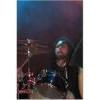Yes, Servant - that is exactly what I was talking about. See I didn't know that mr. Crow wasn't familiar with those concepts.
Now that I think of it, perhaps it's better to resort to just using spheres with more or less polygons. (Render targets and FBO's can be a mouthful, but as Servant mentioned, they really will deliver in terms of performance, if you require many "objects" to show at once.)
Most Graphics APIs (or their extensions) allow creation of spheres given a number of slices. Those can be difficult to texture map, so perhaps you can benefit from doing a little shader programming. It shouldn't take too much effort, though. As with the skybox, those can also be positioned relative to the camera in a manner that make them seem much further away than they really are. (Barrows has some insightful comments on measurements)
You could divide it's size by a certain amount, and then scale its position by the inverse. (I'm not sure the two measurements will be proportional, you'll probably have to square one of them.) It may be necessary to disable drawing to the depth buffer, so nothing drawn afterwards will reveal the trick.
There's so much smoke and so many mirrors available to use, it can be difficult to pick between them. ... But remember to pick.
Once you have set up a wrapper for rendering to textures, the extra work isn't really that bad, and you will benefit from it in the long run.
(Using FBOs in OpenGL)
http://www.gamedev.net/page/resources/_/technical/opengl/opengl-frame-buffer-object-101-r2331
http://www.gamedev.net/page/resources/_/technical/opengl/opengl-frame-buffer-object-201-r2333
(Using render targets to render to texture in DX10)
http://www.rastertek.com/dx10tut22.html
http://www.two-kings.de/tutorials/dxgraphics/dxgraphics16.html
http://www.gamedev.net/topic/576213-directx-10-render-to-texture/








